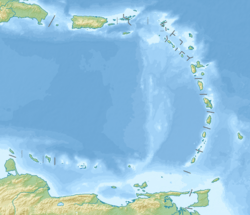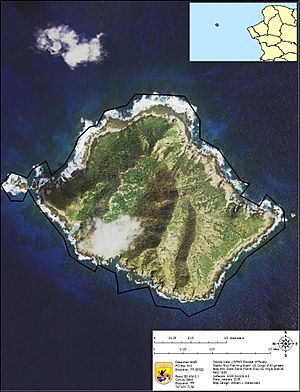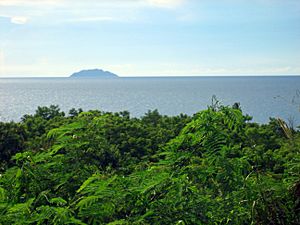Desecheo Island facts for kids
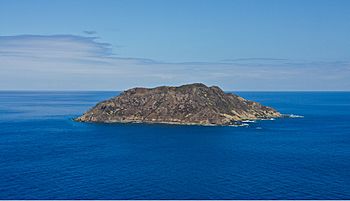
Isla Desecheo, oblique aerial photograph
|
|
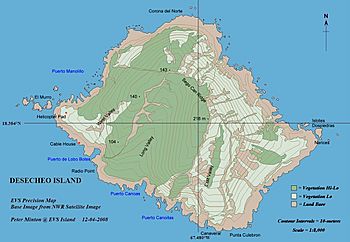 |
|
| Geography | |
|---|---|
| Coordinates | 18°23′14″N 67°28′19″W / 18.38722°N 67.47194°W |
| Area | 1.524613 km2 (0.588656 sq mi) |
| Length | 1.8 km (1.12 mi) |
| Width | 1.1 km (0.68 mi) |
| Highest elevation | 218 m (715 ft) |
| Highest point | Sego Can Ridge |
| Administration | |
| Commonwealth | Puerto Rico |
| Municipio | Mayagüez |
| Barrio | Sabanetas |
Desecheo (which means "Isla Desecheo" in Spanish) is a small island that no one lives on. It is part of the Puerto Rico islands. You can find it in the northeast part of the Mona Passage. It's about 13 miles (21 km) from Rincón on the west coast of Puerto Rico. It's also about 31 miles (50 km) northeast of Mona Island. The island is about 0.589 square miles (1.52 square kilometers) in size. The U.S. Department of the Interior, through the U.S. Fish and Wildlife Service, manages this island.
Contents
Nature on Desecheo Island
Desecheo Island does not have any known rivers or lakes. It gets about 40 inches (1020 mm) of rain each year. The highest point on the island is 715 feet (218 meters) tall. Because there is no surface water, the plants here are mostly thorny shrubs, small trees, and different types of cacti. One special cactus, the Higo Chumbo (Harrisia portoricensis), is an endangered species.
Animals and Wildlife
The island is home to many seabirds. It also has three types of lizards that live nowhere else in the world. These are called Ameiva desechensis, Anolis desechensis, and Sphaerodactylus levinsi.
In the past, some animals were brought to the island by people. These included goats and rats. In 1967, rhesus monkeys were brought here from Cayo Santiago. This was part of a study to see how they would adapt. Before the monkeys arrived, Desecheo was a huge nesting place for brown booby birds. However, after the monkeys were introduced, no seabirds nested on the island for a long time.
Island's Past
No signs of people living on Desecheo before Christopher Columbus have been found. Columbus was the first European to see the island during his second trip to the New World. However, it was named in 1517 by a Spanish explorer named Nuñez Alvarez de Aragón.
Military Use and Protection
In the 1700s, smugglers, pirates, and bandits used the island. They would hunt wild goats that had been brought there. During World War II, and until 1952, the United States military used Desecheo as a place to practice bombing. From 1952 to 1964, the United States Air Force used it for survival training.
In 1976, the U.S. Fish and Wildlife Service took over managing the island. In 1983, it became a National Wildlife Refuge. This means it is a protected area for wildlife. In 2000, it was also made a Marine reserve. This helps protect the ocean around the island. Fishing is allowed within 1/2 mile (0.8 km) of the island.
Protecting Desecheo's Nature
At the start of the 1900s, Desecheo National Wildlife Refuge was a very important place for seabirds to nest. Thousands of birds, like Brown Boobies and Red-footed Boobies, nested there.
Challenges and Recovery
However, animals that were not native to the island, like goats and rats, started to cause problems. These invasive species damaged the island's natural environment. Also, the island being used as an artillery range during World War II caused more harm. By the year 2000, almost no seabirds were nesting on the island anymore.
To fix this, the US Fish and Wildlife Service teamed up with other groups in 2016. They worked together to remove the invasive rats from the island. Just one year later, Desecheo Island was declared free of these invasive animals.
Signs of nature recovering were quickly seen. For example, Audubon's Shearwaters were spotted on the island for the first time. New nests of Bridled Terns were also found. The endangered Higo Chumbo cactus also showed signs of recovery. In 2017, many of these cacti were seen with flowers and large yellow fruits. This was a great sign for their future.
Diving Around Desecheo
Desecheo is a very popular spot for diving fans. This is because of its healthy reefs and very clear waters. You can often see 98 to 148 feet (30 to 45 meters) underwater!
Even though diving is allowed around the island, the island itself is closed to the public. This is because there might be unexploded military items left over from when it was used for bombing practice. People who try to go onto the island can be arrested by federal officers.
Amateur Radio on Desecheo
For amateur radio enthusiasts, Desecheo is considered a special place. It's like a unique "entity" for earning awards. Radio groups have visited the island to make many contacts with other radio operators around the world. The U.S. Fish & Wildlife Service now limits these visits. In 2009, the first approved radio trip in fifteen years happened. They made over 115,000 contacts!
See also
 In Spanish: Isla Desecheo para niños
In Spanish: Isla Desecheo para niños



